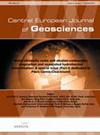Geochemistry and geodynamics of the Mawat mafic complex in the Zagros Suture zone, northeast Iraq
引用次数: 27
Abstract
The Iraqi Zagros Orogenic Belt includes two separate ophiolite belts, which extend along a northwest-southeast trend near the Iranian border. The outer belt shows ophiolite sequences and originated in the oceanic ridge or supra-subduction zone. The inner belt includes the Mawat complex, which is parallel to the outer belt and is separated by the Biston Avoraman block. The Mawat complex with zoning structures includes sedimentary rocks with mafic interbedded lava and tuff, and thick mafic and ultramafic rocks. This complex does not show a typical ophiolite sequences such as those in Penjween and Bulfat. The Mawat complex shows evidence of dynamic deformation during the Late Cretaceous. Geochemical data suggest that basic rocks have high MgO and are significantly depleted in LREE relative to HREE. In addition they show positive ɛNd values (+5 to+8) and low 87Sr/86Sr ratios. The occurrence of some OIB type rocks, high Mg basaltic rocks and some intermediate compositions between these two indicate the evolution of the Mawat complex from primary and depleted source mantle. The absence of a typical ophiolite sequence and the presence of good compatibility of the source magma with magma extracted from the mantle plume suggests that a mantle plume from the D″ layer is more consistent as the source of this complex than the oceanic ridge or supra-subduction zone settings. Based on our proposed model the Mawat basin represents an extensional basin formed during the Late Paleozoic to younger along the Arabian passive margin oriented parallel to the Neo-Tethys oceanic ridge or spreading center. The Mawat extensional basin formed without creation of new oceanic basement. During the extension, huge volumes of mafic lava were intruded into this basin. This basin was squeezed between the Arabian Plate and Biston Avoraman block during the Late Cretaceous.伊拉克东北部扎格罗斯缝合带Mawat基性杂岩的地球化学和地球动力学
伊拉克扎格罗斯造山带包括两条独立的蛇绿岩带,沿西北-东南方向在伊朗边境附近延伸。外带为蛇绿岩层序,起源于洋脊或超俯冲带。内带包括与外带平行的Mawat杂岩,由Biston Avoraman地块分隔。毛瓦特杂岩具有分带构造,包括基性熔岩和凝灰岩互层沉积岩和厚基性和超基性岩。该杂岩不具有典型的蛇绿岩序列,如Penjween和Bulfat。毛瓦特杂岩显示了晚白垩世动态变形的证据。地球化学数据表明,基性岩具有较高的MgO, LREE相对于HREE明显贫化。此外,它们具有正的Nd值(+5 ~ +8)和较低的87Sr/86Sr比值。部分OIB型岩石、高镁玄武岩以及介于两者之间的中间成分的赋存,表明毛窝杂岩是由原生源幔和衰竭源幔演化而来。典型蛇绿岩层序的缺失和源岩浆与地幔柱萃取岩浆的良好配伍性表明,与洋脊或超俯冲带背景相比,D″层的地幔柱更适合作为该杂岩的源。根据该模型,毛瓦特盆地是一个形成于晚古生代至更年轻的伸展盆地,沿平行于新特提斯洋脊或扩张中心的阿拉伯被动边缘发育。毛瓦特伸展盆地是在没有新洋基底形成的情况下形成的。在伸展期,大量的基性熔岩侵入盆地。该盆地在晚白垩世被挤压在阿拉伯板块和Biston Avoraman地块之间。
本文章由计算机程序翻译,如有差异,请以英文原文为准。
求助全文
约1分钟内获得全文
求助全文
来源期刊

Central European Journal of Geosciences
GEOSCIENCES, MULTIDISCIPLINARY-
自引率
0.00%
发文量
0
审稿时长
>12 weeks
 求助内容:
求助内容: 应助结果提醒方式:
应助结果提醒方式:


